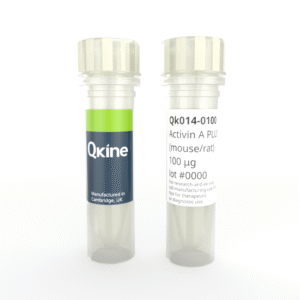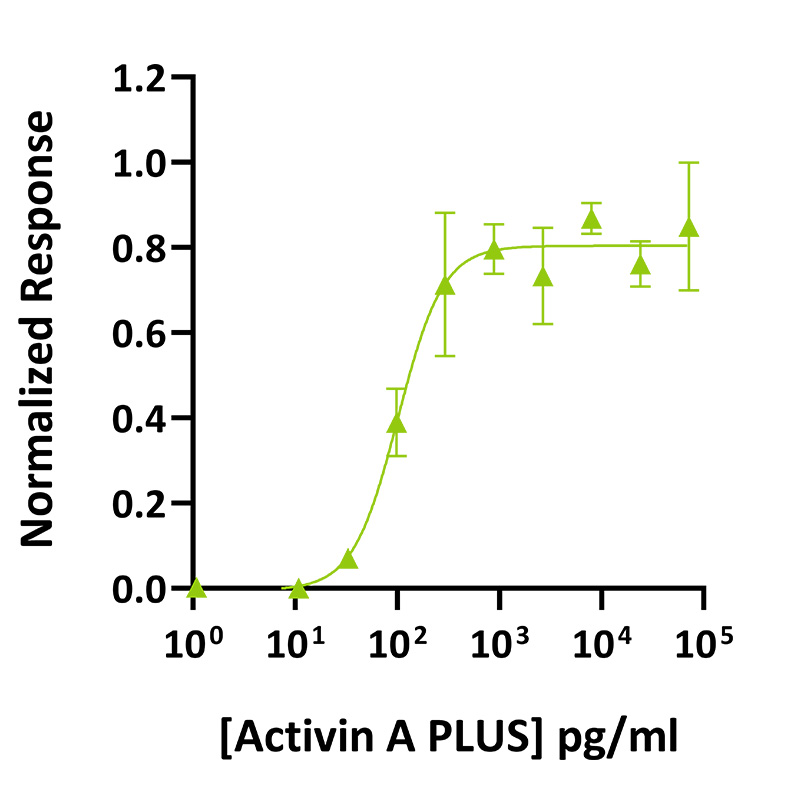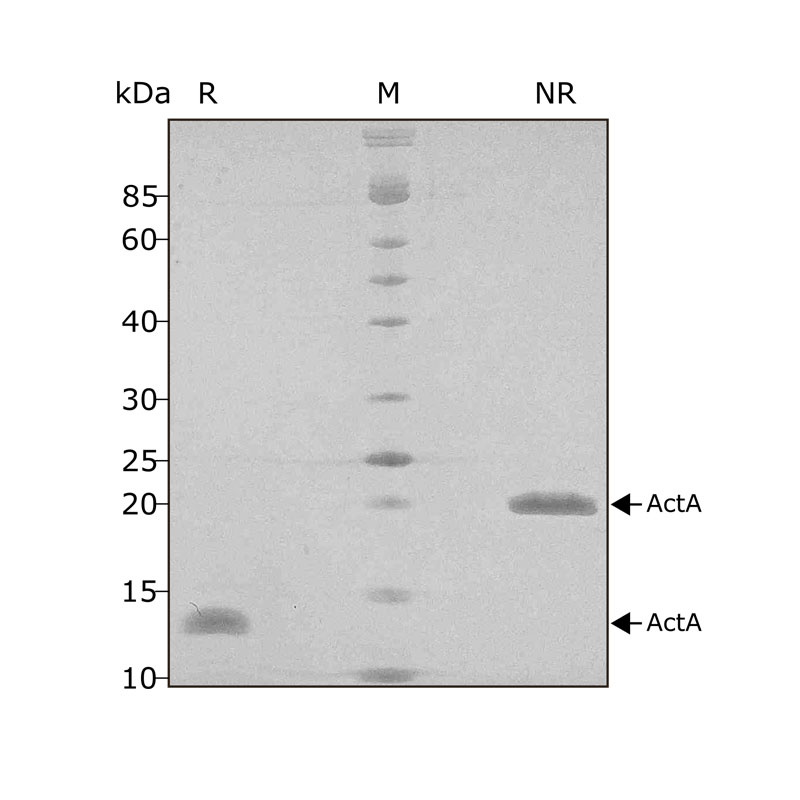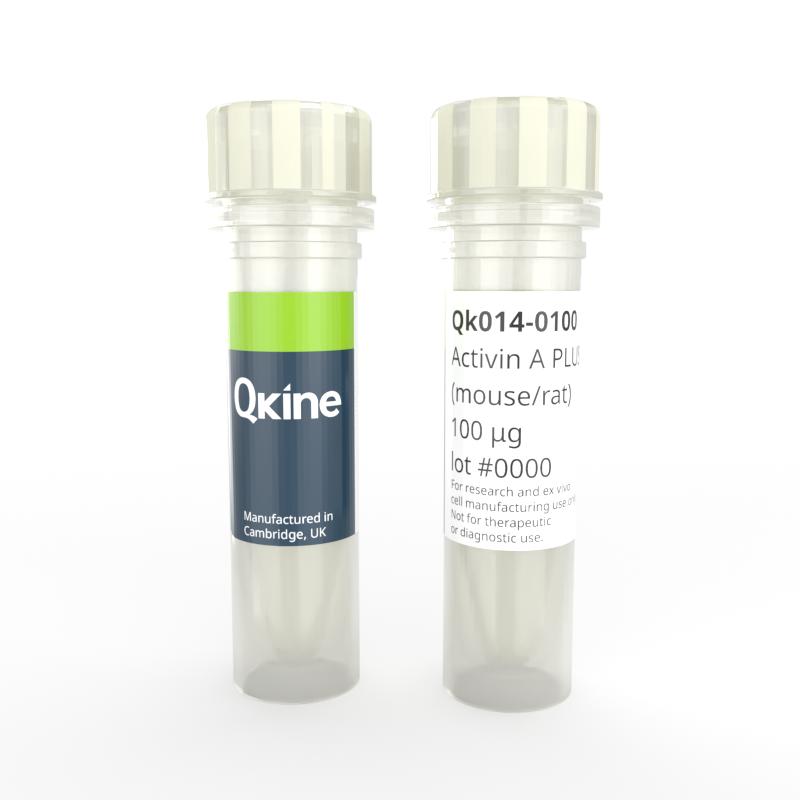 Recombinant mouse/rat activin A PLUS™ protein (Qk014)
Recombinant mouse/rat activin A PLUS™ protein (Qk014)Recombinant mouse/rat activin A PLUS™ protein (Qk014)
Price range: £175.00 through £2,300.00
Mouse/rat recombinant activin A PLUS™ protein is an optimized biologically active truncation of the mature domain of activin A protein. The EC50 and activity in stem cell culture of activin A PLUS is equivalent to the full mature domain activin A.
High purity 24 kDa dimer comprising truncated mature domain of activin A protein, animal origin-free (AOF) and carrier-protein free (CF). Recombinant activin A PLUS™ is designed to be manufactured at scale for cost-effective, large-scale stem cell culture applications.
In stock
Orders are typically shipped same or next day (except Friday).
Easy world-wide ordering, direct or through our distributors.
Price range: £175.00 through £2,300.00
Buy online with secure credit card or purchase order. For any questions, please email orders@qkine.com
Summary:
- High purity optimized mature domain of activin A (Uniprot: Q04998) – particularly suitable for bulk and scale-up stem cell culture applications
- 24 kDa (dimer)
>98%, by SDS-PAGE quantitative densitometry
Expressed in E. coli
Animal origin-free (AOF) and carrier protein-free
Manufactured in our Cambridge, UK laboratories
Lyophilized from acetonitrile, TFA
- Resuspend in 10 mM HCl (Reconstitution solution A) at >50 µg/ml, add carrier protein if desired, prepare single-use aliquots and store frozen at -20 °C (short-term) or -80 °C (long-term)
Featured applications:
Large scale stem cell expansion
Expansion and differentiation of mouse pluripotent stem cells

Activin A PLUS™ activity was determined using an activin-responsive firefly luciferase reporter in HEK293T cells. in triplicate) with a serial dilution of activin A for 6 hours. Firefly luciferase activity is measured and normalized to the control Renilla luciferase activity. EC50 = 0.103 ng/ml (4.24 pM). EC50 is within the expected range of 6 ± 2 pM. Data from Qk005 lot #104344.
Activin A PLUS™ migrates as a single band at 24 kDa in non-reducing (NR) and 13 kDa as a single monomeric species upon reduction (R). No contaminating protein bands are visible. Purified recombinant protein (7 µg) was resolved using 15% w/v SDS-PAGE in reduced (+β-mercaptothanol, R) and non-reduced conditions (NR) and stained with Coomassie Brilliant Blue R250. Data from Qk005 lot #010.

Further quality assays
Mass spectrometry: single species with expected mass
Recovery from stock vial: >95%
Endotoxin: <0.005 EU/μg protein (below level of detection)
We are a company founded and run by scientists to provide a service and support innovation in stem cell biology and regenerative medicine. All our products are exceptionally high purity, with complete characterisation and bioactivity analysis on every lot.
Qkine activin A PLUS™ was as bioactive as activin A protein from an alternative supplier. Activin A activity was determined using the activin-responsive firefly luciferase reporter assay in transiently transfected HEK293T cells. Cells were treated in triplicate with a serial dilution of Qkine activin A PLUS™ (Qk005, green) or alternative activin A (Supplier B, black). Firefly luciferase activity was measured and normalized. Data from Qk005 lot #104344.
Protein background
Activin A is a member of the TGF-β superfamily of growth factors used in stem cell differentiation and maintenance. Activin A PLUS™, an engineered optimized form of activin A, incorporates an N-terminal truncation to remove a disulfide-linked extension. The resulting protein can be manufactured at extremely consistent high yield with no observed changes in bioactivity compared to the wild-type. This form is particularly suitable for large scale stem cell culture processes.
Activin A is involved in regulation of embryogenesis, development of the reproductive system, wound healing and regulation of immune responses in vivo. The activity of activin A is regulated by the high-affinity inhibitor, follistatin [1], and inhibins. Activins are disulfide-linked homo- and heterodimers of four inhibin β chains. The best characterized are activin A and activin B, homodimers of inhibin βA and inhibin βB respectively. Activins, like all other members in the TGF-β superfamily, are synthesized as larger precursors consisting of an N-terminal signal peptide, a pro-domain of 250–350 residues and a highly conserved mature domain. The pro-domain, which is cleaved off in the mature protein, has important roles in the biosynthesis, stabilization, transportation and signaling of the growth factors [2].
Activin A is frequently used for the maintenance of pluripotency of induced pluripotent stem cells and embryonic stem cell lines along with fibroblast growth factor 2 (FGF-2) [3, 4]. Activin A is also used in various stem cell differentiation protocols. It directs the differentiation into definitive endoderm, precursor to different cell types such as pancreatic and liver cells [5]. Activin A also promotes neural precursor cells and drives astrocytic differentiation with Ciliary neurotrophic factor (CNTF) and Glial cell line-derived neurotrophic factor (GDNF) [6]. Moreover, activin A is also involved in mesodermal differentiation to derive muscle, bone, and blood cells [7]. Finally, activin A is often used for the development and maintenance of organoids [8, 9].
Mouse activin A has 100% homology to rat, human, porcine and bovine proteins.
Additional resources
Our products are for research use only and not for diagnostic or therapeutic use. Products are not for resale.
For use in manufacturing of cellular or gene therapy products. Not intended for in vivo applications.

Receive an Amazon gift voucher when you leave us a review.
£25, $30 or €30 for reviews with an image and £10, $15 or €15 for reviews without an image
